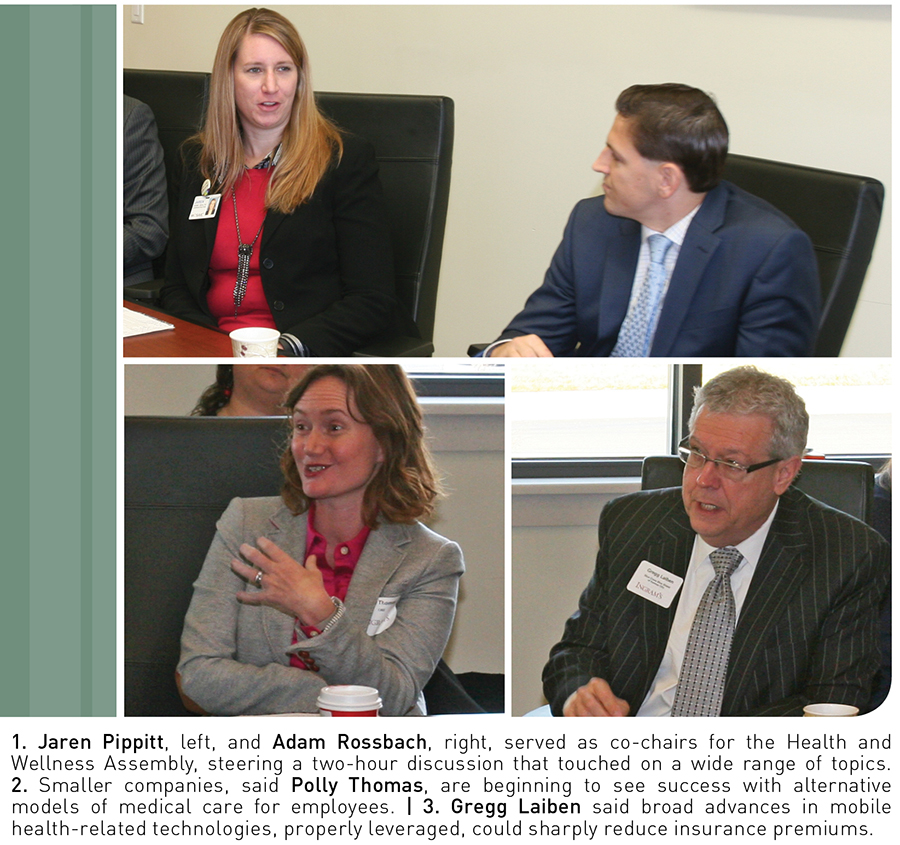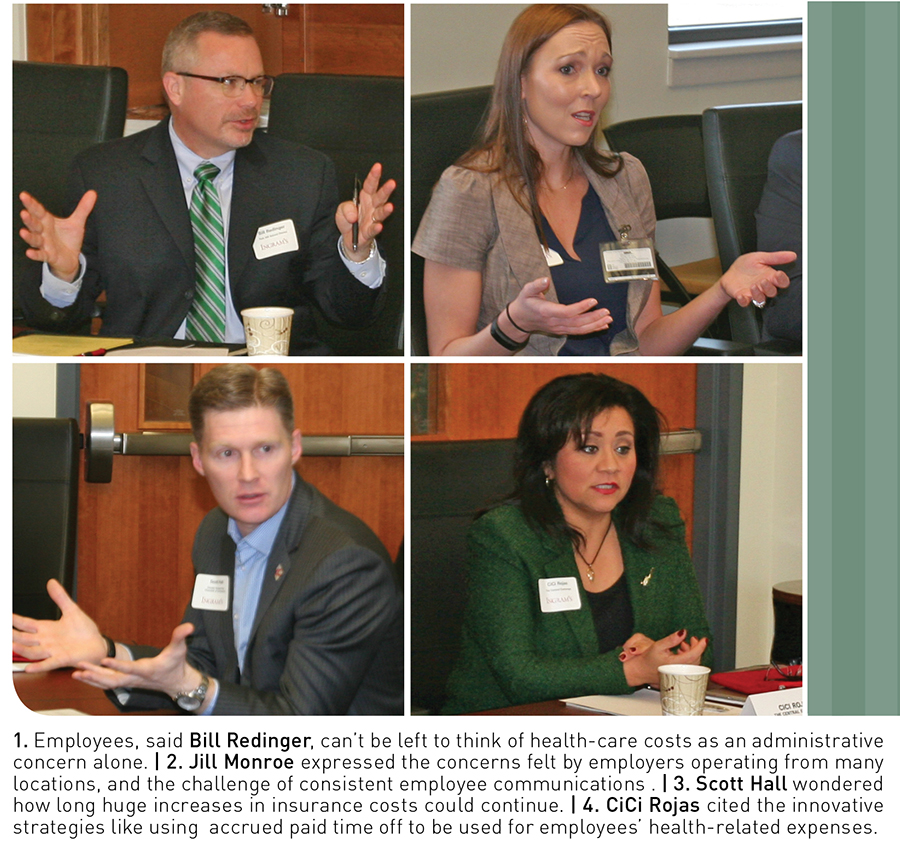HOME | ABOUT US | MEDIA KIT | CONTACT US | INQUIRE
HOME | ABOUT US | MEDIA KIT | CONTACT US | INQUIRE


The current challenges facing the U.S. health care system seem to be as varied as the 318 million Americans that system serves: individual customers with unique health and wellness issues, insurance companies adjusting business models in the post-Affordable Care Act world, insurance brokers trying to help clients navigate waterways that are changing routes daily (sometimes hourly), employers trying to figure out ways to cope with dramatic increases in insurance premiums, and employees who may—or may not—be doing what they can on a personal level to help their employers win that fight.
Those are just for starters.
Each of those stakeholders will view the current and emerging challenges of the health-care sector from different perspectives. And a dozen of those perspectives on issues that are key to the quality of life in the Kansas City area, broadly, and to the region’s sprawling Northland, in particular, convened on Dec. 10 for a unique roundtable sponsored by Mosaic Life Care and hosted at the company’s extraordinary Shoal Creek clinic.
Mosaic Life Care’s Adam Rossbach, director of business solutions, and Jaren Pippitt, home-centric administrator, served as co-chairs for a fast-paced two-hour conversation that covered strategies to bend the cost curve for health care, effective employer wellness programming, technical advances in care and record-keeping, evolution of care settings and other vital topics.
Around the table, participants sounded common themes about the need for more education and engagement, at multiple levels.
In addition to rising drug costs, for example, Jaren Pippitt of Mosaic Life Care and Matt Benge of Assured SRA both identified need to engage and incentivize employees in ways that get them both involved and excited around improving their own well being.
Scott Hall, who’s involved with the Greater Kansas City Chamber of Commerce’s Healthy KC initiative, saw the need for engagement at the business ownership level. “There’s still a reluctance to drive to workplace wellness, because in the short term, it can cost money,” and getting past that initial gut reaction is a huge challenge for many chamber members.
It’s also important, said Bill Redinger, assistant superintendent, human resources for the Park Hill School District, for employees to understand “that we are all in the fight together, specifically around costs. Employees can’t have the impression that it’s merely a matter for their bosses; they have to step up, too.

Barriers, said Polly Thomas, director of clinical consulting services for CBIZ, must fall, particularly those that keep employees from doing a better job of managing health, such as time constraints for working parents, or those caught in a sandwich generation. Employees also need better tools, she said, to determine where to receive quality care, and to understand the cost implications of their own choices about care providers.
For some employers, said Jill Monroe, wellness manger for the city of Kansas City, the challenge is one of location: Companies with multiple offices have a harder time keeping employees on the same page. “We have more than 100 locations,” she said, “so how do we engage those employees and keep wellness in the forefront?”
Cici Rojas, CEO of The Central Exchange and a former Truman Medical Center executive, said incentives play a huge role in getting employees on board—and keeping them there—because “we have to change the behavior of people taking care of well-being.”
Matt Benge cited the benefits of customizing a strategy to the work force. Technology, he said, can help, but wellness “is not a one-time-in-a-year, open-enrollment thing. You’ve got to build your strategy year to year, and leaders have to go all-in on it, or else it’s not going to work.”
Committee-driven change, with broad input, is effective, said Polly Thomas. “That’s the most successful way to build a sustainable effort,” she said. “It takes on a life of its own and becomes self-driven.”
Gregg Laiben of Blue Cross Blue Shield of Kansas City said a multi-pronged approach is vital. “The more you can touch folks, the better chance you’ll have of getting them engaged and keeping them engaged,” he said.
For Jaren Pippitt, more than a decade of concentration on obesity and tobacco use, for example, hasn’t had the impact we might like for reducing the effects of those conditions, which, ultimately, require long-term lifestyle changes. “How do we align incentives for a payoff that’s immediate and tangible, but is still a motivator?” she said.
Tangible tools that work, said Polly Thomas, show employees what’s in it for them, not just for their employer’s bottom line, but “many employers aren’t willing to put the time and the cost into it” to demonstrate that return.
Others, said Matt Benge, court failure if they throw too much at employees, too soon: “You have to do it incrementally, with a stair-step approach,” he said.
One-time classes on issues as complex as diabetes management, said Jill Monroe, are a bust. “That’s not going to change behavior,” she said. Effective instruction “has to be over a long period of time. … Changing behavior takes time.”
Scott Hall said things as basic as a basket of apples in the break room can have an impact, as well as more intense efforts like fitness competitions. “Not everyone is motivated by that,” he said, “but creating friendly ways to compete, to gamify this, really drives people to change behaviors.”
From clinics that may be on site or mobile, from the patient-centered medical home structure to satellite facilities built around holistic approaches to health and wellness, participants explored the changes in the way services are delivered.
Bigger companies, Polly Thomas noted, can justify their investment and succeed with on-site facilities—clinics, medical staff and fitness facilities—but mid-size and smaller organizations are starting to succeed with near-site and shared models. “These seem to be most successful when they integrate with a benefit plan and other resources an employer has,” she said.”

Adam Rossbach noted that Mosaic Life Care itself is committed to innovative, low-cost approaches to wellness, including, he said, “on-site care at a fraction of the cost including on-site telemedicine, which utilizes remote family-medicine physicians” at sites like the Shoal Creek facility.
“We see the growth extend-ing the doctors into places they’ve never been able to be,” said Laiben. “But even that is just a stopgap measure, because the real clinic we’re after, you’re all carrying in your pocket” is the smart phone. The disruptive power of new technology, he said, could cut health-care premiums by 30 percent if we lever-age that technology correctly.
As Jill Monroe and CiCi Rojas noted, confidentiality of individual health records, and potential employer liability for inadvertent release of that information, are large issues.
But with new methods of “seeing” a doctor, “employees need to understand who’s on the other end, and what are their credentials?” said Polly Thomas. “More are apt to use it if they know they’re seeing the same provider every time, or the same group of providers, vs a random person who rotates in.”
That ties in with the next generational tsunami of health-care patients: Millennials entering the work force, already in numbers that exceed the dwindling cohort of Baby Boomers and the subsequent Generation X.
“Millennials want to do everything on their iPhone,” said Adam Rossbach, and that will include health-care delivery.
“People are busy, they’re working, they have kids,” said Jaren Pippitt. “Our goal is to meet them where they are.” Mosaic, she said, is “prepared for that shift to on-demand healthcare, and smart phone, telemedicine and e-consultations are going to boom.
Changes in the efficacy of health-care delivery and wellness programs are vital, said Scott Hall, because “any organism that is healthy will grow faster and grow stronger and thrive more if it’s healthy. That can be a person, a company or a community.”
Most agreed that there will be an increasing emphasis on other dimensions of health and wellness besides physical well-being, including financial, mental and behavioral health, spiritual health, and the health of one’s relationships.
To that extent, employers should provide incentives, said Polly Thomas, that “are not just focused on physical health, but other dimensions. There’s a lot of evidence on the power that volunteerism has.” So a paid day off to work for a charitable cause has a place in a company’s overall strategy, or allowing employees to direct any financial incentives due them toward a particular charity.
“In describing the pillars of wellness, from a human capital perspective, that gives us the opportunity to have a dialog with employees, and shows that, as an organization, we value our people,” said Jim Fight, human resources officer for the Kansas City Area Transportation Authority. “We’re looking to be impactful in people’s lives beyond services they provide to us to improve our bottom line.”